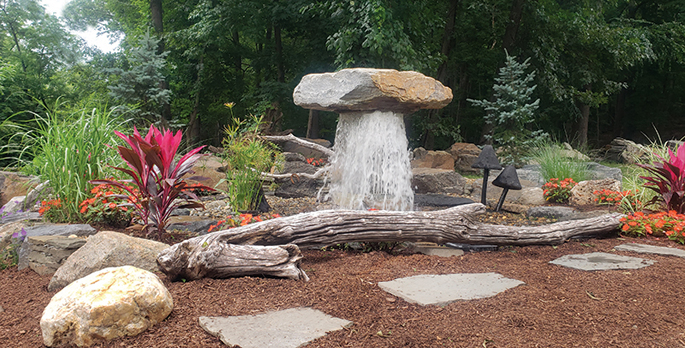
Our Liquid Designz showroom is situated on a fairly busy, double-lined county road in Northern New Jersey. It presents a perfect opportunity to showcase some of our beautiful work as close to the road as possible, so passing traffic can view one or both of our two displays flanking the corners of our property, approximately 150 feet apart.
On one side we have a lovely, multifaceted design, which includes multiple spillway bowls, urns, gorgeous driftwood, large rocks and colorful plantings along with a Jersey-shore theme of thick rope running through three sets of pylons. The other side has our latest “insane,” floating 1-ton boulder that you see pictured here.
However, it was a bit of a journey to get to this point.
Mother Nature Strikes
It started about three years ago when a storm blew through the area, knocking down an enormous tree onto some live wires. At the time, no displays were located there, as it served as nothing more then a place for us to receive stone deliveries. I didn’t realize that because the tree was partially located on my property, the power company was only obligated to cut the parts of the tree that were hanging on the wires and clean any debris off the road. I wasn’t home at the time, but I was ready to lose it when I noticed every branch, limb and trunk that was thrown onto my property.
I decided to remain calm and was fortunate enough to be able to move everything out of the way with our MT52, except for the largest piece of the tree. It was lying mainly in the woods adjacent to our property, but it extended about 10 feet onto my property. I turned this negative into a positive and built a small, cool-looking pondless waterfall with water originating from inside the large piece of tree section on my property. It was nice for a while, but I tend to get bored quickly.
Fast-forward about three years, and I was cleaning out a residential pond for my largest commercial client, the CEO of a major hospital in New Jersey. He told me they were looking to do something fairly impressive at the hospital’s hospice location, which sits on 25 acres and backs up to a natural wetland. I would be working with another hospital contractor I was already close with, who had an amazing crew of guys. I was very excited about the opportunity.
The first thing on my list was to ask the CEO one simple but telling question: “Did you want Six Flags or Disney?” Without any hesitation, his answer was — you guessed it — Disney. “Good choice,” I told him.
Making Magic
So, the project had everything — a large pond with massive boulders, a wetland filter with a small stream running to one end of the pond, a 90-degree, 9,000-gallon reservoir that wrapped around a huge, porcelain tile patio, and massive seating boulders up close and personal, where the pond falls into the negative edge.
All this, and yet the coolest part of the project was not shown on the plans at all. Fortunately, the CEO trusted me, and when he heard the words “Miracle Boulder,” he figured it went well with the unfortunate theme of a hospice location. This project was being constructed for the countless families of loved ones who would soon be passing on. The Miracle Boulder was to be situated as a circular pondless feature set up to start the 50-foot stream, which would lead back to the pond on the other side. The Miracle Boulder was to be 8 feet above the water and natural looking. This was the farthest point out in this huge, open field.

Larger plantings would have followed. Did you catch that? Would have followed. Unfortunately, the town shut down all construction after we finished installing the huge reservoir and ground water pumps, as the water table was high.
So as things were being worked out at the hospice location, I certainly wasn’t going to hang around. I told my contractor buddy I was going to build the Miracle Boulder at our showroom right where that darn tree came down. “Sure you are,” he said. Two days later, the initial little pondless feature I had built there was ripped out, and I started my search for the right-sized materials to complete this “insane” design. It would have to be slightly scaled down and completely pondless based on the grade of the property and the location of the design.
Don’t get me wrong. I was very disappointed regarding the stop-work order. However, while I was working at the hospice location, I had run into Matt, a very nice guy who owned an excavating company called Hartman Excavating. I decided to call him and ask him if he remembered me — which I knew he did, because I was the nice guy who asked him to get off his machine and give us a hand with our 35-by-100 liner for the negative-edge reservoir. It was a blistering 98 degrees in a wide-open area. “Please don’t ever ask me to do that again,” he said.
We laughed a bit on the phone, and then I explained my vision to him regarding this “insane” design concept. “I have to be part of that,” he replied.
So, the team was set. It was Matt, Paul (my foreman at the time) and, of course, yours truly. Little did I know what challenges were ahead of us.
Getting to Work

First off, Paul and I ripped out the old pondless design and cut back the huge tree about another 6 feet so I could visualize my new design. We started with a boulder and a very rough, stacked stone retaining wall in a semicircle. Once the wall was completed, I needed Matt to use his small excavator to break up the hard clay and deep base of an old fieldstone retaining wall, along with years of tandems and tri-axles compacting the area with countless stone deliveries. He was very busy at the time, so after he broke up the soil, it was all hands on deck to start digging out the reservoir, or so I thought.
I realized that the 6-by-6-by-2 footing, which would be situated in the center, had to be formed and excavated first. Once that was complete, we followed up with our Liquid Designz unique, thick gray underlay, followed by the 25-by-50 main liner. We then added another layer of the thick gray fabric. The footing was excavated, lined, protected and ready for a short pour of concrete, which was a nightmare in and of itself.
It was time to reach out to Matt again, as we needed him to set the vertical rock just after the concrete was poured. I had the vertical rock strapped perfectly, and it was ready to go. Unfortunately, the shoot would not reach our footing area. The only thing we had to do was pull up the liner so I could get in close with the MT52. I also made it very clear to my foreman to be careful that no portion of the liner would be cemented over. The vertical rock was set perfectly. We chained it to Matt’s front-end loader and let it sit overnight. One crucial step was complete, with more to soon follow.
Now that the liner was in and the vertical support stone was securely in place, it was time to precisely measure, cut and drill the area on the underside of the large, slab-style stone that would be placed on top. We could only pray that those holes lined up with the vertical stone where our galvanized steel pins were recessed. Again, it would require Matt in his machine, my foreman and yours truly on the ground. We had one side of the boulder labeled “Street,” which was our guide. As precise as our cut and drilled holes for the steel pins had to be, we were almost dead-on. The boulder was to be recessed onto the vertical stone while we lined up the holes with the steel pins. The plan was to have Matt position the boulder over the center of the vertical stone while I would slightly spin and hold it with the MT52. My foreman was our eyes. It took a few shots, but we were triumphant. It was such a relief to get this portion of the design completed.
Challenges Abound

Some acute aggravation followed. Remember how we were rushed with the short pour? Well, as I went out the following morning to start pulling out the liner to gauge our reservoir excavation, I realized a section of our liner had gotten under a portion of the cement. To say I was livid would be an understatement. So with a little demo, sawing very carefully, I was finally able to free the liner. I did not have to compromise the footing, of course; I just had to cut away a fair amount of excess concrete.
Next, our reservoir was hand-dug with the aid of our Bosch electric jackhammer and formed a 600-gallon reservoir in a horseshoe shape. Once completed, the most difficult part of the design was up next. Let’s just say that one company gave me a price to build our manifolds for $10,000, and that wasn’t happening. The easy part was determining the correct pumps needed to create such a strong water push, with serious flow at low head. The real challenge was determining how to create a two-sided curtain of water so the vertical structure could not be seen at all while running. A series of 30 jets had to placed close, but not too close, together to achieve the look we were going for.
Obviously, on our next install, there will be a 360-degree visual, so the pumps will be that much stronger. We will use many more jets, and we will move up to two 4-inch lines, opposed to two 3-inch lines.
Our final challenge came after our first test run. I had to figure out how I would control the splashing outwards while the intense water pressure was hitting the underside of our floating boulder. To make this work and form that illusion, the water from the jets had to be perfectly straight on the way up and again on the way down — similar to bumpers on a pool table, if you will. This took a bit of creativity. The underside of the rock surface obviously had to be cushioned in such a way. I had the perfect solution and I nailed it the first time.
There’s unique creativity, and then there’s “way outside the box” creativity. But none of it matters unless the design comes to fruition and the execution is perfect. The design, though small in actual real estate, was our most challenging to date. Its beauty during the day and night, with water and no water, is the most gratifying part to me.



Jerry, yes you did nail it. The job came out beautiful. I can only assume there are not many floating boulders in Bergen County or the surrounding areas. That would be a special project for the right customer. Whether it’s as large as yours or smaller, it’s very creative. Whatever the projects are, having the right crew and dedicated employees is huge in the creation of waterfalls and Ponds of every type. As a landscape design / build contractor myself, the end result in creating beautiful landscapes is the reward in and of itself . Again great work to you Jerry and the crew.